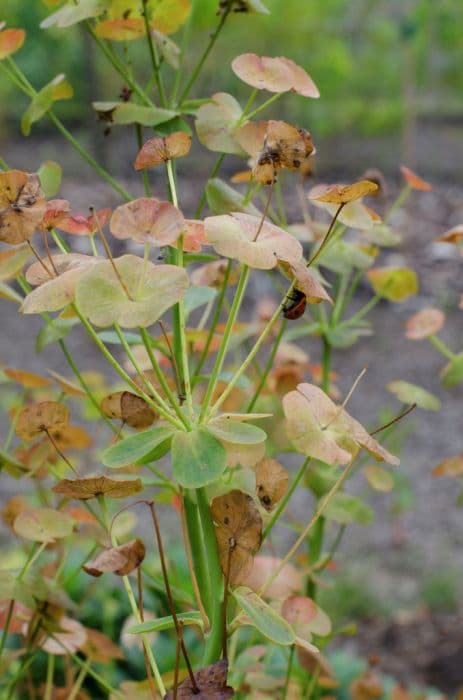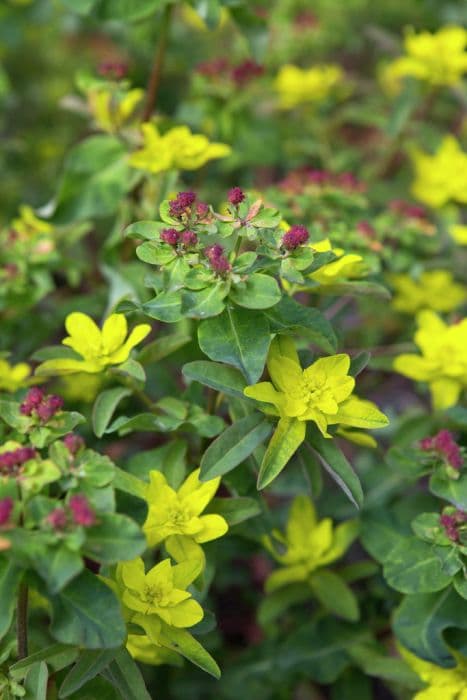Euphorbia milii var. splendens

ABOUT
Crown of Thorns is a plant with a unique and striking appearance. Its woody, grayish stems are densely covered with sharp, long thorns. This structure gives the plant a somewhat spiky and formidable look, as the thorns can be quite intimidating to touch. Along the stems, you'll find small, oval-shaped leaves that are a lush green color. These leaves may fall off during drought conditions, which the plant is perfectly adapted to endure. One of the most captivating features of Crown of Thorns is its flowers, or more accurately, the brightly colored bracts that surround the actual tiny flowers. These bracts come in a variety of colors, including vibrant reds, pinks, yellows, and sometimes even white, which add a splash of color and contrast beautifully with the green foliage. The true flowers are small and inconspicuous, nestled within the showy bracts. The Crown of Thorns blooms throughout the year if it receives enough light, which makes it a popular choice for a flowering houseplant. The colored bracts and modest flowers can appear in clusters atop the stems, giving it a festive and continuous display of color that can enliven any space. Despite its somewhat aggressive look, due to the thorns, many people are drawn to this plant for its drought tolerance and the consistent pop of color it provides.
About this plant
 Names
NamesFamily
Euphorbiaceae
Synonyms
Crown of Thorns, Christ Plant, Christ Thorn
Common names
Euphorbia splendens, Euphorbia milii.
 Toxicity
ToxicityTo humans
Crown of Thorns is considered toxic to humans. The main concern is the white, milky sap, which contains diterpene esters. If this sap comes into contact with skin, it can cause irritation, redness, and swelling. If it comes into contact with eyes, it can cause severe pain and possible temporary blindness. If ingested, the sap can cause burning pain in the mouth, throat, and stomach, followed by nausea, vomiting, and diarrhea. It is essential to handle this plant with care and to wash hands thoroughly after contact.
To pets
Crown of Thorns is also toxic to pets. The sap contains skin-irritating and stomach-irritating compounds known as diterpene esters. If a pet chews or ingests this plant, they might experience drooling, mouth pain, vomiting, and diarrhea. Direct contact with the sap can also cause skin and eye irritation. Therefore, pets should be kept away from this plant, and any incidents of ingestion should warrant a prompt visit to the veterinarian.
 Characteristics
CharacteristicsLife cycle
Perennials
Foliage type
Evergreen
Color of leaves
Green
Flower color
Red
Height
3 feet (0.91 meters)
Spread
1.5 feet (0.46 meters)
Plant type
Shrub
Hardiness zones
9
Native area
Madagascar
Benefits
 General Benefits
General Benefits- Decorative: Crown of Thorns (Euphorbia milii var. splendens) has vibrant flowers and a unique appearance that add aesthetic appeal to gardens and homes.
- Drought-tolerant: This plant can survive with minimal watering, making it suitable for dry climates and water-conserving gardens.
- Easy to care: Crown of Thorns is low-maintenance, requiring little attention beyond basic sunlight and occasional watering.
- Resilient: It is known for its hardiness and can withstand less than ideal conditions, such as poor soil quality.
- Long blooming: The plant produces flowers for a prolonged period, often year-round in the right conditions, providing consistent color.
- Pest resistance: Crown of Thorns is resistant to many pests, reducing the need for chemical treatments.
- Adaptable as a houseplant: It can be grown indoors, allowing people without gardens to enjoy its beauty.
- Can be used in xeriscaping: Its drought tolerance makes it an ideal choice for water-efficient landscaping.
 Medical Properties
Medical Properties- Analgesic properties: Euphorbia milii var. splendens has been used traditionally in some cultures to help alleviate pain.
- Antibacterial effects: Some studies suggest that extracts from the plant may have properties that inhibit the growth of certain bacteria.
- Antifungal activity: It may also have the potential to act against certain types of fungal infections.
- Traditional use for warts: The latex of the plant has been applied to the skin to treat warts, although this use might carry risks due to its potentially irritating and toxic properties.
 Air-purifying Qualities
Air-purifying QualitiesThis plant is not specifically known for air purifying qualities.
 Other Uses
Other Uses- Euphorbia milii var. splendens, commonly known as Crown of Thorns, can be used as a natural barrier due to its spiky stems. Its thorns can deter animals and unauthorized persons from entering private properties.
- In some cultures, the Crown of Thorns is associated with good luck and prosperity, and thus it is used as part of rituals or kept in homes and businesses for this reason.
- The plant is sometimes used in crafting and jewelry-making, where the thorns can be incorporated into beads or pendants after proper treatment.
- Crown of Thorns is employed in drought-resistant landscaping to reduce water use and maintain green spaces with its ability to thrive in arid conditions.
- Because of its striking appearance, the Crown of Thorns is used for educational purposes in botany and horticulture to demonstrate plant adaptations such as succulent leaves and thorns.
- This plant is occasionally used in water-conserving container gardens where water retention is essential, and its low water needs make it a suitable choice.
- Crown of Thorns branches can be used as a natural fish deterrent in garden ponds; the submerged thorns can help to keep certain predators at bay.
- During certain festivities or in cultural practices, the Crown of Thorns may be used for decorative crown-making, symbolizing various aspects of folklore or tradition.
- The sap of Crown of Thorns, which is toxic, has historically been used as a component in arrow poisons by some indigenous groups.
- In artistic installations and avant-garde floral arrangements, the unique form and texture of the Crown of Thorns are sometimes featured to add an edgy and exotic element to the composition.
Interesting Facts
 Feng Shui
Feng ShuiThe Crown of Thorns is not used in Feng Shui practice.
 Zodiac Sign Compitability
Zodiac Sign CompitabilityThe Crown of Thorns is not used in astrology practice.
 Plant Symbolism
Plant Symbolism- Persistence and Endurance: Also known as Crown of Thorns, Euphorbia milii var. splendens, is a hardy plant that can withstand harsh conditions, symbolizing the ability to persist and endure challenges.
- Christian Symbolism: The common name 'Crown of Thorns' is associated with the crown of thorns worn by Jesus during the crucifixion, making this plant a symbol of faith and sacrifice in Christian traditions.
- Luck and Prosperity: In some cultures, the Crown of Thorns is believed to bring good fortune and prosperity to its owners, often associated with Feng Shui practices.
- Protection: Due to its thorny exterior, this plant is often considered a symbol of protection, safeguarding against negative influences and providing a barrier against harm.
 Water
WaterCrown of Thorns should be watered when the top inch of soil feels dry to the touch, approximately once a week. It is important not to overwater as this can lead to root rot. In a typical indoor setting, watering with about 8 ounces of water should be sufficient, but always check the soil moisture before adding more water. During the winter, reduce watering frequency allowing the soil to dry out more between waterings.
 Light
LightCrown of Thorns prefers bright, indirect sunlight to maintain its vibrant colors and promote blooming. It should be placed in a spot where it can receive at least four to six hours of sunlight daily, such as a south-facing or east-facing window. Direct hot sun might scorch the leaves, so a little shade during the peak hours is beneficial.
 Temperature
TemperatureCrown of Thorns thrives in warm conditions and should be kept in temperatures ranging from 60 to 85 degrees Fahrenheit. It can tolerate temperatures as low as 50 degrees Fahrenheit, but frost or temperatures below this can be harmful to the plant. It is well-suited to typical indoor room temperatures.
 Pruning
PruningPruning Crown of Thorns is necessary to maintain its shape, encourage bushier growth, and remove any damaged or diseased stems. It's best to prune in the early spring before new growth begins. Cut back up to one-third of the plant, using gloves to protect against its thorny stems and milky sap, which can be irritating to the skin.
 Cleaning
CleaningAs needed
 Soil
SoilCrown of Thorns prefers a well-draining soil mix, such as cactus potting mix, mixed with perlite or pumice to increase drainage. The ideal soil pH range for the Crown of Thorns is between 6.0 and 7.5.
 Repotting
RepottingCrown of Thorns should be repotted every 2-3 years, or when it outgrows its current pot, to provide fresh nutrients and encourage growth.
 Humidity & Misting
Humidity & MistingCrown of Thorns thrives in average home humidity levels, but can tolerate lower humidity without any adverse effects.
 Suitable locations
Suitable locationsIndoor
Place Crown of Thorns in bright light, avoid overwatering.
Outdoor
Grow Crown of Thorns in sunny spot, protect from frost.
Hardiness zone
9-11 USDA
 Life cycle
Life cycleEuphorbia milii var. splendens, commonly known as Crown of Thorns, begins its life as a seed, which once germinated in warm conditions, will sprout into a seedling. The seedling grows into a vegetative state, characterized by the development of thick, succulent stems and small, spiny leaves. As the plant matures, it enters the flowering stage where it produces bracts, often mistaken for petals, which surround the tiny true flowers called cyathia. Following pollination, which is commonly carried out by insects, the plant produces fruits that are three-lobed capsules, each containing a seed that, when mature, bursts open to disperse the seeds. The Crown of Thorns then enters a period of dormancy in cooler or drier conditions, slowing its growth and minimizing water loss. The cycle can repeat as dispersed seeds germinate, or the plant may also propagate vegetatively through cuttings that take root and grow into new individuals.
 Propogation
PropogationPropogation time
Spring-Early Summer
The most popular method of propagating the Crown of Thorns, or Euphorbia milii var. splendens, is through cuttings. The ideal time for taking cuttings is during the warmer months when the plant is actively growing, typically from late spring to early summer. To propagate by cuttings, a 3 to 6 inch section of a healthy stem is snipped off using a sharp, sterilized knife or scissors. The cut end should be allowed to dry and callous over for a few days to avoid rotting when placed in soil. Once the cut end has healed, the cutting is planted in a well-draining soil mix, with roughly an inch of the stem buried beneath the soil surface. The cutting should be kept in a warm environment with indirect light and consistent moisture, but not waterlogged, to encourage root development. In a few weeks, the cutting will establish roots and can be treated as an independent plant.


![Spurge [Silver Swan]](/_next/image?url=https%3A%2F%2Fplants-admin.emdemapps.com%2Fimages%2Fplants%2F%2Fimages%2F604b573f6c8f6.png&w=640&q=75)






